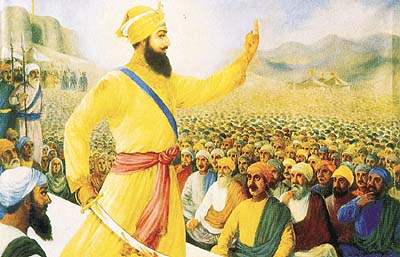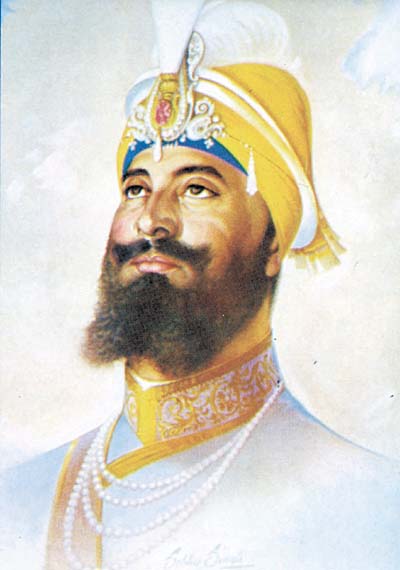




















 

 |
Khalsa
epitomises valour, freedom & dignity
By Satish K.
Kapoor
THE creation of the Khalsa by Guru
Gobind Singh marks the crystallisation as well as the
extension of the message of Guru Nanak Dev and the
subsequent Sikh Gurus. It was a historic event with
mutagenic implications. While tenaciously holding to the
spiritual tradition of his predecessors, Guru Gobind
Singh introduced a new element into it — the element
of vigour.
The Khalsa coalesced
serenity and strength, purity and power, shastra
(scripture) and shastra (weapon), the power of
wisdom (janana shakti) and the power of action (kriya
shakti) so that the primordial cosmic energy in each
human being could assume a dynamic form to withstand
injustice and oppression.

Henceforth, mukti
(salvation) from political or social oppression was to
precede mukti from the cycle of birth and death. Love for
God was to be accompanied by love for mankind. The divine
spirit was to be perceived in man and vice-versa. To the
list of human weaknesses such as kama (lust),
krodha (anger), lobha (greed), moha
(attachment) and ahamkar (vanity) was added
another, the feeling of timidity. The truly religious man
was one who could shed every drop of his blood to
safeguard the interests of the weak, the helpless, and
the downtrodden and who never surrenders or submits in
the battlefield of life. True pilgrimage was the
pilgrimage to death for the fulfilment of a noble cause.
The spiritual introvert who withdrew from the scene of
turmoil to chant the holy syllables was unworthy of
respect.
The Khalsa was to be a
vehicle for liberating the mind of the community from
fears and complexes, its body from the clutches of
repressive rulers and its soul from the bondage of the
clergy. The intermediaries of religion were rendered
obsolete; the institution of masands, who had
betrayed the path of righteousness, was abolished.
Apostolic succession came to an end and the Holy word
reflecting through Granth Sahib was metamorphosed
into a living Guru for all time to come.
The profound impulse for
the establishment of the Khalsa did not come only from
the historical milieu but from the divine urge to uphold
dharma and to re-establish virtue. Centuries of foreign
rule had demoralised the Hindu community and rendered it
spineless. Torn by the division of castes and endangered
by the onslaught of Islam, it needed rejuvenation. Hindu
dharma was in danger of being gobbled up by the
proselytising zeal of rulers like Aurangzeb who viewed
India as Dar-Al-Harb (the domain of infidels) and
endeavoured to convert it into Dar-Al-Islam (the
domain of the faithful). His anti-Hindu measures like the
reimposition of (Jiziya) and pilgrim tax (earlier
abolished by Akbar), restrictions on the celebrations of
festivals like Diwali, Dasehra and Holi, demolition of
thousands of temples, including Vishwanath temple of
Banaras, the Keshav Rai temple of Mathura and the temple
of Somnath, imposition of higher customs duty on goods
handled by Hindu merchants, rendering the Hindus
ineligible for the posts of revenue collector of the
Khalsa land, changing the name of Mathura to Islamabad
and forcible conversions to Islam, instilled a sense of
fear and consternation among members of the community.
Timidity led to passivity,
passivity to helplessness and helplessness to the need of
a redeemer. This became possible by the divine mission of
Guru Gobind Singh through the institution of the Khalsa.
The dramatic act of Guru
Gobind Singh at Anandpur Sahib on the Baisakhi day of
1699 (March 30) in asking for the heads of five Sikhs one
after another, was a crucial test of the sense of
obedience and devotion of his disciples. The bhakti
concept of prapatti was brought into vogue in a
martial way. Prapatti involves the total
submission of a disciple to the divine spirit or its
embodiment, the Guru, and is tantamount to his death in
the mental, material and psychic terms. This makes the
resurrection possible.
Guru Gobind Singh was
aware that if each could merge his individual self into
the greater self of the community, it could lead to the
formation of a Brihatkutumba or a large family
strong enough to withstand pressure.

The five
Sikhs who had offered themselves for sacrifice came from
different castes and regions: Daya Ram was a Sobti Khatri
of Lahore, Dharma Das, a Jat from Hastinapur, Muhkam
Chand, a washerman from Dwarka, Himmat, a water-carrier
from Jagannath Puri and Sahib Chand, a barber from Bidar
(Karnataka). After going through a simulated ordeal, they
were designated as Panj Piare or the five beloved
ones, and initiated into the order of the Khalsa through
the baptism of the sword (khande di pahul). The
prevalent mode of initiation by charnamrit
(partaking of water in which the feet of Guru had been
bathed) was abandoned as it betokened bhakti not
shakti, besides, it left a hiatus between the guru
and his disciple. The Khalsa, on the other hand, was
invested with the power of the Guru after Gobind Singh
himself received baptism at the hands of Panj Piare who
had metamorphosed as from Sikhs into Singhs or lions. The
Guru merged in the Khalsa and the Khalsa in the Guru,
"wherever there are five Sikhs assembled, know that
I am there", observed Guru Gobind Singh. "The
Khalsa is my other self; in him I live and have my
being."
The baptismal ceremony was
free from exculpatory rites, magical formulae, caste
distinctions and archaic sacraments. Rituals were
observed to de-ritualise religion and relate it to the
stark reality of the time which required bravery and
strength to face a tyrannical regime. Such was the level
of enthusiasm that over 20,000 persons joined the rank of
the Khalsa that day. In times to come, the Khalsa became
the vanguard of freedom and human dignity.
Interestingly, the numeral
five figured prominently in the initiatory rites as
evidenced by the selection of Panj Piare mixing of
five sweetening agents, namely treacle, white sugar, red
sugar, candid sugar and honey in water and consecrating
it by chanting five banis — Japuji, Jap,
Chaupai, Swaiyya and Anand, administering
five palmsful of baptismal water, and making it
obligatory for every Sikh to wear the Five K’s
— Kesha (long hair), Kangha (comb), Kara
(steel bracelet), Kachh (short drawers) and
Kirpan (sword).
The baptised Sikhs were
not to relinquish the world, do penance or penitence,
perform sacrifices or worship idols. They were not to
hide in cloistered surroundings like Benedictine monks or
move about like mendicant friars but lead a
householder’s life and fulfil social and political
obligations according to the exigencies of circumstances.
They were not to trim hair, commit adultery, partake
halal meat or use tobacco. Each was to make four solemn
promises: that he would have no pride of profession or
position (Kritanash vow) or of high birth (Kulnash
vow), that he would reject orthodox beliefs (Dharm-anash
vow) and redundant customs (Karmanash vow) and
follow the path laid down by the Guru. But the Khalsa was
not to apotheosise anyone, not even Guru Gobind Singh.
"Any one who calls me God; in the fire of hell shall
surely fall", wrote the Tenth Sikh Master.
The Khalsa was to wield
arms to protect dharma from the concussive assaults of
the Mughal regime under Aurangzeb. "I shall make
sparrows fight hawks, then alone may I be called Guru
Gobind Singh". Historical events proved the veracity
of the Guru’s words. The Zafarnama or
"Epistle of Victory" which he addressed to
Aurangzeb during the darkest hour of his life bespeaks of
his indomitable courage and supreme will.
The new salutation "Waheguru
Ji Ka Khalsa, Waheguru Ji Ki Fateh"
("Khalsa belongs to God; the victory, is therefore,
God’s own") became a potent mantra for the
community. When chanted by the group it created a force
field of energy which cast a spell on the timid and the
effeminate, who showed instant readiness for service and
sacrifice. The unity thus achieved was rich in spiritual
potential. At social level it dissolved the distinctions
based on caste, creed and status. At political level, it
sounded the bugle of sovereignty of the Sikh
congregation.
The creation of the Khalsa
led to the dawn of a new faith. It’s task was to
protect and safeguard the same community from which it
had sprung. The Khalsa was to epitomise purity as the
pure alone can be fearless; the fearless alone can be
brave and the brave alone have the courage to die for a
cause. 
|

